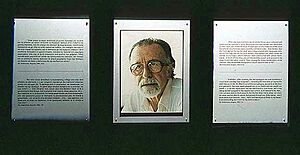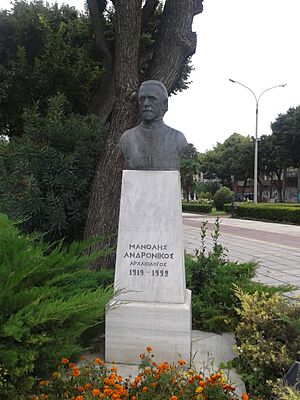Manolis Andronikos facts for kids
Quick facts for kids
Manolis Andronikos
|
|
|---|---|

A picture of Andronikos in Vergina
|
|
| Born | October 23, 1919 |
| Died | March 30, 1992 (aged 72) |
| Nationality | Greek |
| Alma mater | University of Thessaloniki Oxford University |
| Known for | Discovering the tomb of Philip II of Macedon |
| Scientific career | |
| Fields | Archaeology |
| Institutions | Aristotle University of Thessaloniki |
Manolis Andronikos (Greek: Μανόλης Ανδρόνικος) was a famous Greek archaeologist. He was born on October 23, 1919, and passed away on March 30, 1992. He worked as a professor at the Aristotle University of Thessaloniki. Andronikos is most famous for finding the tomb of Philip II of Macedon. This was a very important discovery in the world of archaeology!
Contents
Early Life and Education
Manolis Andronikos was born in a place called Bursa (Greek: Προύσα). At that time, Bursa was part of the Ottoman Empire. His father came from the island of Samos, and his mother was from Imbros. Later, his family moved to Thessaloniki, a big city in Greece.
He first studied philosophy at the Aristotle University of Thessaloniki. In 1952, he became a professor of Classical Archaeology at the same university. He also continued his studies at Oxford University in England from 1954 to 1955. He returned to the Aristotle University of Thessaloniki in 1957. There, he taught Archaeology, first as an instructor and then as a full professor starting in 1964.
Personal Life and Interests
Manolis Andronikos was married to Olympia Kakoulidou, who was a school teacher. He really enjoyed reading poetry. Some of his favorite poets were Kostis Palamas, Giorgos Seferis, and Odysseas Elitis. He also helped start a local cultural group called Art (Greek: Η τέχνη).
Archaeological Discoveries
Manolis Andronikos led many archaeological digs. He worked in places like Veroia, Naousa, Kilkis, Chalkidiki, and Thessaloniki. But his most important work happened in Vergina. His former teacher, Professor K. Rhomaios, had started excavations there in 1937.
Andronikos made his greatest discovery on November 8, 1977. He found a tomb in Vergina that he believed belonged to Philip II of Macedon. Philip II was the father of Alexander the Great. This tomb was special because it had not been robbed. It contained many valuable items, including a golden larnax. A larnax is a small chest or box, often used for holding ashes or treasures.
The amazing items found in this tomb were later shown in a special exhibit. It was called "The Search for Alexander." This exhibit traveled to four cities in the United States between 1980 and 1982. While many archaeologists agree the tomb belongs to Philip, some still debate it. However, if it's not his, another tomb in the same area likely is.
Later Life and Legacy
Andronikos was a member of several important archaeological groups. These included the Archaeological Council and the German Archaeological Institute in Berlin. He lived in Thessaloniki and passed away on March 30, 1992, after an illness. His work greatly helped us understand ancient Macedonian history.
See also
- Ancient Macedonians
- Macedon
- Vergina Sun
Images for kids



